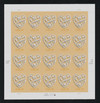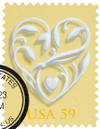
# 4272 - 2008 59c Wedding Series: Wedding Hearts - yellow background
59¢ Wedding Heart
Issue Date: June 10, 2008
City: Washington, DC
Hearts have long been the symbol of love and often associated with weddings. A heart-shaped, intertwined vine is featured on this Wedding Series stamp, designed to be used on a two-ounce wedding invitation.
Although the origin of the wedding ceremony may be difficult to trace, the practice of sending invitations is thought to have begun in Europe in the Middle Ages. Before Johannes Gutenberg invented the printing press in the 1400s, most Europeans were illiterate. Weddings were typically announced by a town crier. He walked through the streets, loudly singing out the news of the day, including any upcoming weddings. All who heard the announcement were invited.
Wealthy families, more likely to be literate, commissioned monks skilled at calligraphy to create handwritten invitations. In time, Gutenberg’s printing press brought literacy to more and more people. Then, an improvement to the press in 1642 made printed wedding invitations available to brides. These first “engraved” invitations were protected from smudging by a sheet of tissue paper, a tradition followed today. The invitations, delivered by hand or horseback, were sealed in a double envelope to protect them from damage. Although postal delivery is much more reliable today, two envelopes are still used.
59¢ Wedding Heart
Issue Date: June 10, 2008
City: Washington, DC
Hearts have long been the symbol of love and often associated with weddings. A heart-shaped, intertwined vine is featured on this Wedding Series stamp, designed to be used on a two-ounce wedding invitation.
Although the origin of the wedding ceremony may be difficult to trace, the practice of sending invitations is thought to have begun in Europe in the Middle Ages. Before Johannes Gutenberg invented the printing press in the 1400s, most Europeans were illiterate. Weddings were typically announced by a town crier. He walked through the streets, loudly singing out the news of the day, including any upcoming weddings. All who heard the announcement were invited.
Wealthy families, more likely to be literate, commissioned monks skilled at calligraphy to create handwritten invitations. In time, Gutenberg’s printing press brought literacy to more and more people. Then, an improvement to the press in 1642 made printed wedding invitations available to brides. These first “engraved” invitations were protected from smudging by a sheet of tissue paper, a tradition followed today. The invitations, delivered by hand or horseback, were sealed in a double envelope to protect them from damage. Although postal delivery is much more reliable today, two envelopes are still used.














